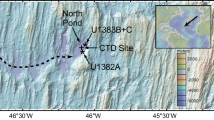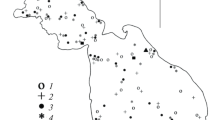Summary
Bathythermograms just off the northern edge of the Gulf Stream often show temperature inversions, while those in the Gulf Stream and the Sargasso Sea do not show such features. A similar situation was found in the Kuroshio area. TheT-S curve obtained off Cape Hatteras with a bathysalinograph and a bathythermograph indicates that the temperature inversions correspond to high salinity and less stable density stratification. Sequential surface temperature charts suggest that the inversions may be caused by sinking of the warm and saline Gulf Stream water. When such water is driven into the slope water region, it is cooled by mixing or heat transfer to the atmosphere, but retains its high salinity and sinks. A simple mathematical model is developed based on an assumption that an isolated water mass is enclosed in a parcel with a flexible and permeable membrane. The initial density inside the parcel is different from the one outside and the water mixes with the surrounding water. When it is assumed that mixing of temperature occurs faster than that of salinity, the isolated Gulf Stream water sinks to an equilibrium depth, causing temperature peaks and inversions in the subsurface layer.
Similar content being viewed by others
References
J. Crank,The Mathematics of Diffusion (Oxford-Clarendon Press, 1957), 84–87.
A. Defant,Physical Oceanography, Vol. 1 (Pergamon Press, 1962), 202–218.
G. B. Dowling,The Bathyconductograph, a new oceanographic tool (Abstract), J. Geophys. Res.66 (1961), 2526.
C. Eckart,Hydrodynamic of Oceans and Atmospheres (Pergamon Press, 1960), 290.
W. L. Ford, J. R. Longard andR. E. Banks,On the nature, occurrence and origin of cold low salinity water along the edge of the Gulf Stream, J. Mar. Res.11 (1952), 281–293.
F. C. Fuglister andA. D. Voorhis (1965)A new method of tracking the Gulf Stream, Limnol. Oceanog.10, Supplement (1965), 115–124.
T. Ichiye,Geostrophic Eddies, Part I. Technical Report No. CU-21-65 to the Atomic Energy Commission (unpublished manuscript), (1965), 26.
T. Ichiye,Hydrographic structure of an eddy on the edge of the Gulf Stream off Cape Hatteras (Abstract), Trans. Amer. Geophys. Union47, (1966).
T. Ichiye andF. C. W. Olson,Über die neighbour diffusivity im Ozean, Deutsch Hydrog. Zeits13 1 (1960), 13–24.
H. Kawai,Notes on the inversion of the upper water temperature in the waters to the northeast of Japan in summer. Bull. Tohoku Reg. Fish. Res. Lab.6 (1955), 71–80.
R. Kuroda,Notes on the inversion of water density in the vertical distributions of sea water density, Bull. Tohoku Reg. Fish. Res. Lab.11 (1958), 82–87 (in Japanese).
H. Stommel,The Gulf Stream, 2nd Ed. (Univ. of Calif. Press, 1963), 248.
Author information
Authors and Affiliations
Additional information
LGO Contribution No. 1052.
Rights and permissions
About this article
Cite this article
Ichiye, T. Occurrence of temperature inversions in the upper layer of the ocean. PAGEOPH 67, 143–155 (1967). https://doi.org/10.1007/BF00880572
Received:
Issue Date:
DOI: https://doi.org/10.1007/BF00880572




